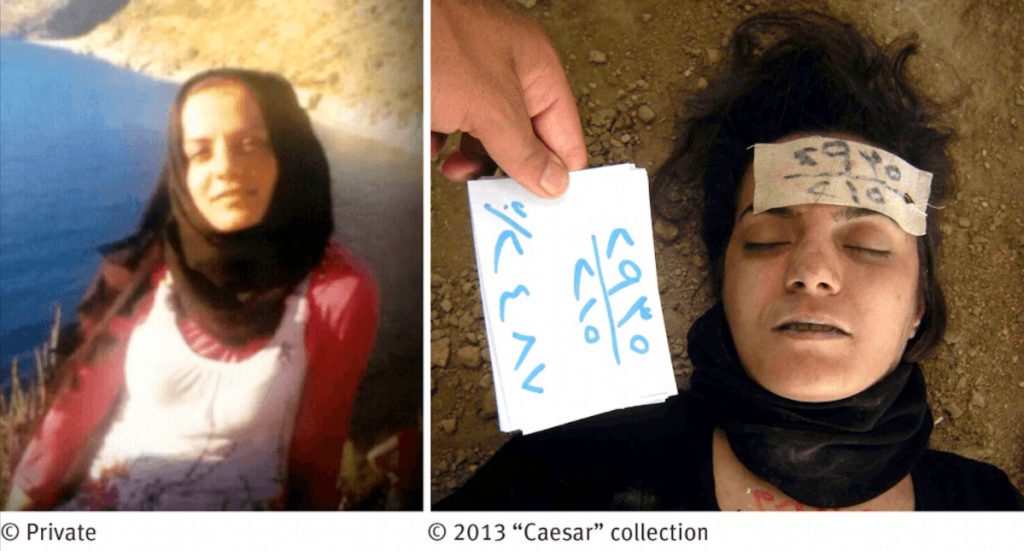From a Human Rights Watch Report
Ahmad al-Musalmani was a 14-year old boy from Namr, Daraa. Before the uprising in Syria began, he was in the seventh grade. After Ahmad’s older brother Shadi was shot and killed on March 23, 2011 during an early protest in Daraa, Ahmad’s family sent him to Lebanon for his safety. Ahmad was thirteen years old when he left Syria for Lebanon.
Ahmad’s mother died of natural causes in Syria while he was apart from the family in Lebanon. On August 2, 2012, when he was fourteen, he returned to Syria to attend his mother’s funeral. He was traveling in a minibus with five other people. One of them later located Ahmad’s family and described his arrest to them. Family members told HRW that according to Ahmad’s fellow passenger, officers from the Air Force Intelligence stopped the car at al-Kiswa bridge checkpoint, on the road between Damascus and Daraa, and an officer asked Ahmad, “Why are you crying?” Ahmad answered, “I am crying because my mother died.”
The officer took the passengers’ phones and started to search them, and he found an anti-Assad song on Ahmad’s phone. He began insulting Ahmad, calling him “you animal,” and other swear words. Then he dragged Ahmad into a small room at the checkpoint, his fellow passenger told the family the day after the incident. The rest of the passengers continued on without him.
Ahmad’s uncle, Dahi al-Musalmani, served as a judge for 20 years in Syria before he fled the country in March 2013. Dahi told Human Rights Watch that he went to see several government officials after Ahmad’s disappearance, including Minister of Social Reconciliation Ali Haydar, to obtain news about Ahmad’s case. He called the 248 Security Branch, controlled by the Military Intelligence agency, to inquire if Ahmad was being held there, after a tip from one of these contacts, but they told him Ahmad was not among the detainees.
In December 2012, five months after Ahmad’s arrest and still without any news about him, a man with strong government contacts whom Dahi declined to identify came to Dahi’s office and told him that if he paid 600,000 Syrian pounds (approximately US$8,451 at that time), Ahmad would be released. The man told him the money was for a pro-Assad member of parliament. Dahi paid the man and accompanied him to drop off the money. After ten days, he said, he received a call from the man.
“Ahmad is alive,” the man told me. “He is detained in the Air Force Intelligence branch in Zablatani.” I told him, “I want Ahmad to be released.” He answered, “You wanted to know his whereabouts, now you know. If you want more you will have to pay two million Syrian pounds. I responded, “I do not have this kind of money, I would have to be a thief or very rich. “Dahi sold some land, and raised one million pounds (approximately US$ 14,085 at that time), but the man told him it was not enough. “I started to beg him,” he said. “I am a judge and I became a beggar. I am a judge and I will kiss his feet so that he accepts.” He accompanied the man and waited in the car while he delivered the money. Dahi said he saw the MP, accept the bag of money. The man returned and told Dahi that Ahmed would be released in ten days. But Ahmed did not come home.
Three months later, Dahi received a call from the Air Force Intelligence branch in Zablatani requiring him to appear at the branch. “My nephews told me not to go. [They said] ‘they will arrest you and kill you,’” Dahi told Human Rights Watch. He and his nephews left for Jordan the next day. On March 16, the day they left, family members who remained behind informed him, his house was raided.
The family continued to search for Ahmad from Jordan, and to appeal in the media for his release.
When the photographs were released, Dahi searched for Ahmad among them.
I went directly to the folder of the Air Force Intelligence, and I found him. [he breaks down while talking] It was a shock. Oh, it was the shock of my life to see him here. I looked for him, 950 days I looked for him. I counted each day. When his mother was dying, she told me: ‘I leave him under your protection.’ What protection could I give?
Five photographs of Ahmad appeared among the Caesar photographs. The photographs appeared in a folder dated August 2012—the month of his arrest. Human Rights Watch shared these five photographs with Physicians for Human Rights, whose forensic pathologists observed that they depicted a boy in his teenage years with several marks of blunt force trauma.





